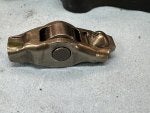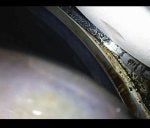New to the forum and Jeeps, I hope someone can point me in the right direction. 2015 JKUR 3.6l 6MT purchased by me six months ago with 77,000 miles. A few weeks ago at 80,000 miles I replaced the oil cooler, spark plugs, and coils with OEM parts, and did an oil change. About 250 miles later I had a check engine light come on for P0306 Cylinder 6 Misfire. I cleared the code and immediately started using Jscan to monitor misfire counts, and sure enough it was showing an intermittent misfire on cylinder 6. All other cylinders stayed near zero. Unfortunately I didn’t monitor this before doing the work above. From what I can see, the misfire would occur when I was at very light throttle, such as going downhill, but not off-throttle engine braking. I pick up 1-3 misfires when upshifting, but the count really climbs when at part throttle and light engine load. The misfire count hit over 300 in about 30 minutes, with most of those while descending a mountain pass. It does not occur during idle, acceleration, or cruising. I was towing a small 1500lbs teardrop when I got the CEL, but the misfire continues to show (without throwing a CEL) driving around town. The Jeep drives great, idles smooth, and doesn’t have any rocker ticking that I can hear.
Maybe unrelated, but about 50 miles later I had P06DE “Engine oil pressure control circuit stuck on” CEL, and thanks to Jscan I was able to confirm the oil pressure was staying around 60psi during cruising on the highway around 2,000rpm. This I understand normally means the solenoid on the oil pump has failed requiring an oil pump replacement.
The fact that the misfires occur during light throttle and low load made me suspect a vacuum leak. I flashbacked to when I was struggling to get the upper intake manifold back on and suspected maybe I pinched or damaged the gaskets. So I pulled the upper intake manifold off and didn’t find anything obvious. I replaced with new gaskets, and also swapped coil #6 with coil #1 while I was in there. I buttoned it back up and took it for a test drive – no change, still getting an intermittent misfire on cylinder #6 under the same conditions.
I pulled the upper intake manifold again and ran a compression test – between 160psi and 170psi on all cylinders. Aware of the known rocker arm issues on the 3.6l I decided to remove the valve cover to check. Cams look fine and there is no obvious rocker damage that I can tell. The rockers have a small amount of movement if you twist them with your finger around where they connect on top of the spring, but no side to side movement that I’ve seen in youtube videos. Nothing unique about the cylinder 6 rockers compared to cylinders 2 and 4. I do see some metal “fuzz” on the magnetic portions of the cam sensor tone rings which indicates some steel has been wearing, but maybe this is just from break in? Oil galley plugs were loose but not backed out.
Just out of curiosity I put pressure on the cooling system for 24 hours to see if I get any seepage into the cylinder, but when I checked with a borescope it was dry.
I’m not sure where to go next. I’m debating pulling the lower intake manifold and checking it for cracks, and replacing the lower gaskets. Maybe swapping injectors to see if the misfire moves? I have not pulled the camshafts to directly inspect the rockers but maybe I should? What am I missing?
EDIT 5/8/25 - SOLVED. Took it to a shop that diagnosed it as a cylinder head issue. Rebuilt cylinder head and now misfire is gone. Hope this can help anyone with the same symptoms.
Maybe unrelated, but about 50 miles later I had P06DE “Engine oil pressure control circuit stuck on” CEL, and thanks to Jscan I was able to confirm the oil pressure was staying around 60psi during cruising on the highway around 2,000rpm. This I understand normally means the solenoid on the oil pump has failed requiring an oil pump replacement.
The fact that the misfires occur during light throttle and low load made me suspect a vacuum leak. I flashbacked to when I was struggling to get the upper intake manifold back on and suspected maybe I pinched or damaged the gaskets. So I pulled the upper intake manifold off and didn’t find anything obvious. I replaced with new gaskets, and also swapped coil #6 with coil #1 while I was in there. I buttoned it back up and took it for a test drive – no change, still getting an intermittent misfire on cylinder #6 under the same conditions.
I pulled the upper intake manifold again and ran a compression test – between 160psi and 170psi on all cylinders. Aware of the known rocker arm issues on the 3.6l I decided to remove the valve cover to check. Cams look fine and there is no obvious rocker damage that I can tell. The rockers have a small amount of movement if you twist them with your finger around where they connect on top of the spring, but no side to side movement that I’ve seen in youtube videos. Nothing unique about the cylinder 6 rockers compared to cylinders 2 and 4. I do see some metal “fuzz” on the magnetic portions of the cam sensor tone rings which indicates some steel has been wearing, but maybe this is just from break in? Oil galley plugs were loose but not backed out.
Just out of curiosity I put pressure on the cooling system for 24 hours to see if I get any seepage into the cylinder, but when I checked with a borescope it was dry.
I’m not sure where to go next. I’m debating pulling the lower intake manifold and checking it for cracks, and replacing the lower gaskets. Maybe swapping injectors to see if the misfire moves? I have not pulled the camshafts to directly inspect the rockers but maybe I should? What am I missing?
EDIT 5/8/25 - SOLVED. Took it to a shop that diagnosed it as a cylinder head issue. Rebuilt cylinder head and now misfire is gone. Hope this can help anyone with the same symptoms.

















